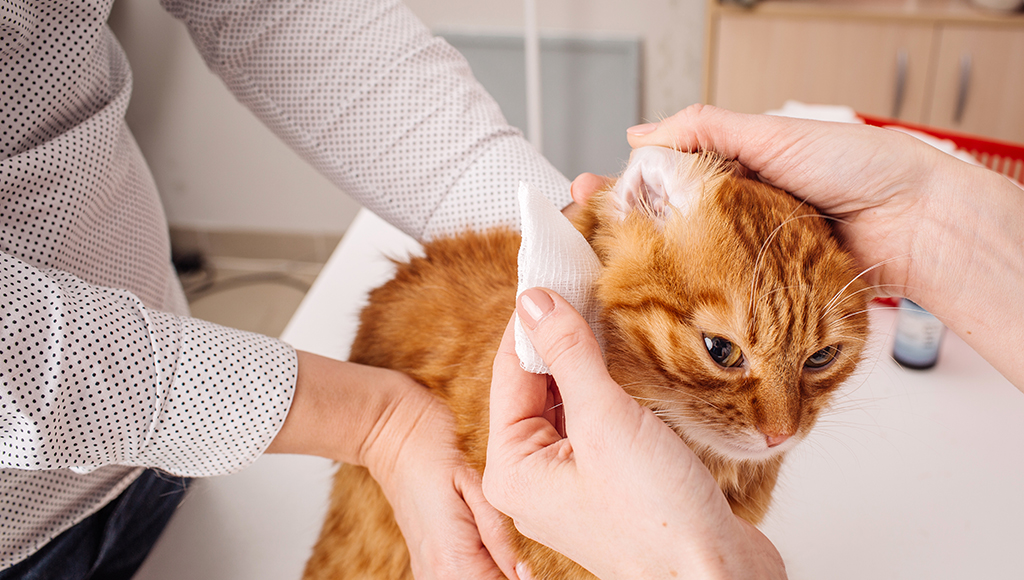Ear Infections in Cats and Dogs
Ear infections can easily become chronic, so early treatment and proper care is important.

Ear infections are a very common problem in dogs and cats. There
are many different causes and numerous treatment regimens to
affect a cure. Hygiene is of major importance both in curing the
problem and most importantly in prevention of recurrence. Ear
infections can easily become chronic in nature, so proper therapy
early in the course of the disease is important, along with long
term commitment to keeping the ears as clean as possible at all
times.
Dogs and cats ears differ from human ears in several significant
ways. The main difference is the shape and length of the ear
canal. It is longer in animals and has a downward and then inward
direction. Cleaning them requires more effort than in people.
Because the external ear canal in animals takes a downward and
inward path, when you clean the ears you will gently be pulling
up on the external ear to straighten this canal out and allow
deeper penetration of medication.
SYMPTOMS
Pets commonly give their owners a clue that their ears are
bothering them. Most pets will either have discharge, odor, or
will be shaking their head more than usual. Sometimes the ear
flap will become extremely swollen-this is called an aural
hematoma. Pets that have a foreign body in their ear like a fox
tail will be shaking their head extensively and frequently paw at
the affected ear.
POSSIBLE CAUSES
Ear disease is caused by many different and predisposing factors,
some of them working in combination:
• Anatomy - deep ear canals and long floppy ears are predisposing causes because they set up a warm and moist environment that bacteria and fungi thrive in.
• Breed - Some breeds like Cocker Spaniels are commonly affected because of allergies, long floppy ears, and inbreeding.
• Allergy - In addition to causing itchy skin and hair loss in general, allergies can also cause ear problems.
• Low Thyroid - On occasion low thyroid hormone can cause ear problems
• Parasites - Ear mites are also a cause of ear disease, especially in cats
• Drug reactions - Any drug can cause a reaction that inflames the ear, so if your pet is taking medication for a condition, you might want to keep close watch on their ears for any signs of inflammation.
• Hygiene - Debris in the ear canal can cause an infection
• Immune system diseases
DIAGNOSIS
Since there are many causes to ear disease an accurate diagnosis
is essential to relieving the problem. Several diagnostic tests
are routinely used:
A routine physical exam is used on every pet that is presented
with ear problems because ear infections can be a sign that there
are problems elsewhere in the body. This exam is an essential
part of the diagnostic process and might include routine blood
work.
Ear swabs are used to obtain a sample of discharge for
microscopic analysis. Microscopic analysis of the discharge helps
determine if your pet's problem is bacterial or fungal related.
This analysis is performed by taking some of the discharge from
the ear canal, staining it blue with a special stain, and
observing how many bacteria or fungi are noted. A culture of the
discharge from the ear is sometimes used as an aid to determine
what bacteria or fungus is causing the problem. Since many
organisims are usually grown in a culture, and some of them are
normal inhabitants, this test is not always advantageous. The
otoscope is an important tool that allows us to visualize the
anatomy of the external ear canal, including the ear drum. It is
also used to retrieve foreign bodies, usually foxtails, from the
ear canal, and to check for tumors. Checking for proper thyroid
levels is also an important test in every dog that has recurring
problems, such as in Golden Retrievers.
In addition to these procedures, allergy tests are also utilized
when they are suspected as the cause of the problem. A blood
sample may also be taken to test for allergies to food, commonly
found material inside of your house, and plant like materials
found throughout our area in the outdoors. Your doctor will let
you know if this test is needed.
TREATMENT
Each ear infection requires specific treatment depending on the
results of the physical exam and diagnostic tests. If there are
underlying problems your doctor will prescribe medication to
prevent them. In the overwhelming majority of cases medical care
is all that is needed. Surgical correction of an ear infection is
usually used only after medical care has been unable to control
the problem.
For the majority of ear infections proper cleaning and routine
topical medication will correct the problem. In some pets the
ears are so inflamed that its painful to clean the ears. In these
severe cases sedation may be used along with flushing. A warm
cleansing solution is used to remove debris and infection from
deep within the ear canal by flushing action only. Learning how
to clean your pet's ears is crucial. Once you have an ear
infection under control, which takes 3-7 days in most cases, your
goal should be to clean your pet's ears once or twice each week
in order to prevent recurrence. Infections that continually recur
are very painful and substantially decrease your pet's quality of
life.
Your doctor will routinely prescribe two medications. The first
is used to gently clean the ear canal and remove debris and
infection. The second medication is a combination preparation
that kills either bacteria, fungi, or parasites. These
medications usually contain an anti-inflammatory preparation to
help soothe the ear. Occasionally your doctor will prescribe oral
medication to clear up the infection and to decrease the
inflammation in the ear canal.
Many dogs have hair inside of the ear canal. This hair is removed to facilitate cleaning and to let air circulate into the ear canal. This should be done routinely, which for most dogs is once monthly. These ears are typical of a pet that needs the hair removed from its ears and a thorough cleaning.
Ready to start saving money on pet wellness care?
Then take a look at Mint Wellness, the pet wellness plan that provides fast reimbursement on routine pet care. Save on vaccinations, wellness exams, preventatives, dental, and more!
Learn More


